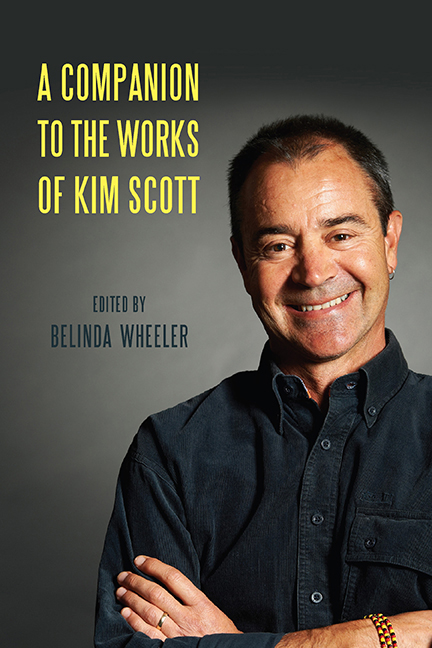Book contents
- Frontmatter
- Contents
- Foreword
- Acknowledgments
- Note on Orthography
- Chronology of Key Writings
- Introduction
- 1 Kim Scott’s Publishing History in Three Contexts: Australian Aboriginal, National, and International
- 2 Kim Scott’s True Country as Aboriginal Bildungsroman
- 3 The Land Holds All Things: Kim Scott’s Benang—A Guide to Postcolonial Spatiality
- 4 Kim Scott’s Kayang and Me: Noongar Identity and Evidence of Connection to Country
- 5 “Wreck/Con/Silly/Nation”: Mimicry, Strategic Essentialism, and the “Friendly Frontier” in Kim Scott’s That Deadman Dance
- 6 The International Reception of Kim Scott’s Works: A Case Study Featuring Benang
- 7 Traumatic Landscapes: Inscribing Spectrality and Identity in Kim Scott’s “A Refreshing Sleep,” “Capture,” and “An Intimate Act”
- 8 Spatial Poetics and the Uses of Ekphrasis in Kim Scott’s “Into the Light” and Other Stories
- 9 The Poetry of Kim Scott
- 10 The Wirlomin Project and Kim Scott: Empowering Regional Narratives in a Globalized World of Literature
- 11 Kim Scott as Boundary Rider: Exploring Possibilities and New Frontiers in Aboriginal Health
- 12 An Interview with Kim Scott
- Notes on the Contributors
- Index
8 - Spatial Poetics and the Uses of Ekphrasis in Kim Scott’s “Into the Light” and Other Stories
Published online by Cambridge University Press: 08 May 2021
- Frontmatter
- Contents
- Foreword
- Acknowledgments
- Note on Orthography
- Chronology of Key Writings
- Introduction
- 1 Kim Scott’s Publishing History in Three Contexts: Australian Aboriginal, National, and International
- 2 Kim Scott’s True Country as Aboriginal Bildungsroman
- 3 The Land Holds All Things: Kim Scott’s Benang—A Guide to Postcolonial Spatiality
- 4 Kim Scott’s Kayang and Me: Noongar Identity and Evidence of Connection to Country
- 5 “Wreck/Con/Silly/Nation”: Mimicry, Strategic Essentialism, and the “Friendly Frontier” in Kim Scott’s That Deadman Dance
- 6 The International Reception of Kim Scott’s Works: A Case Study Featuring Benang
- 7 Traumatic Landscapes: Inscribing Spectrality and Identity in Kim Scott’s “A Refreshing Sleep,” “Capture,” and “An Intimate Act”
- 8 Spatial Poetics and the Uses of Ekphrasis in Kim Scott’s “Into the Light” and Other Stories
- 9 The Poetry of Kim Scott
- 10 The Wirlomin Project and Kim Scott: Empowering Regional Narratives in a Globalized World of Literature
- 11 Kim Scott as Boundary Rider: Exploring Possibilities and New Frontiers in Aboriginal Health
- 12 An Interview with Kim Scott
- Notes on the Contributors
- Index
Summary
KIM SCOTT's “INTO THE LIGHT” (2000) reprises the title of a painting described as “one of Australia's greatest Federation pictures,” in which a lone protagonist takes a flock of sheep through “a triumphal gateway of monumental gums” (Lock-Weir, 68). This exegesis of Droving into the Light, as the painting's title now stands (see fig. 8.1), continues with reference to the artist's skill in his evocative, even Arcadian, depiction of gum trees together with an almost transcendental use of antipodean light. The sense of radiance thus evoked is consistent with other contemporary appraisal of this work, and also with Heysen's comment that “the Sun—its light and warmth—is my religion” (in Thiele, 12).
These elements certainly exist, yet the presence of three puncta, or points through which the viewer may enter the picture, provide indications of more obscure activity and concerns, subconscious or otherwise, in this painting—a black dog, a horse's bunched tail, and a shape that could be a discarded coat, a depression in the earth the sun has yet to reach, or a shadow brought about by the interplay of light among the branches. These exist as lacunae, gaps, or dark spaces that inform the work as much as the promised light ahead. The horse is being ridden by a man hunched over it, his face hidden, his skin completely covered or obscured from the spectator's gaze, which in vain may seek to track his slow-seeming movements into the expanse that appears to open out ahead of him. The man may be defending himself against the sun, the light, or something else that he senses before him. His demeanor suggests a realization that the light may not be that of sublime radiance so much as threat, as it hangs over the promise of verdant pastures ahead.
Such contradictions are apt when considered together with Lionel Lindsay's comment on Heysen as a “master of chiaroscuro” (Thiele, 10). As if to complement this appraisal, Scott's story covers barely four pages in a dark, ekphrastic response. The protagonist is a settler of uncertain provenance, who rides away from his home, “his outcast wife [and] insistently Aboriginal” children (“Into the Light,” 121).
- Type
- Chapter
- Information
- A Companion to the Works of Kim Scott , pp. 101 - 113Publisher: Boydell & BrewerPrint publication year: 2016



